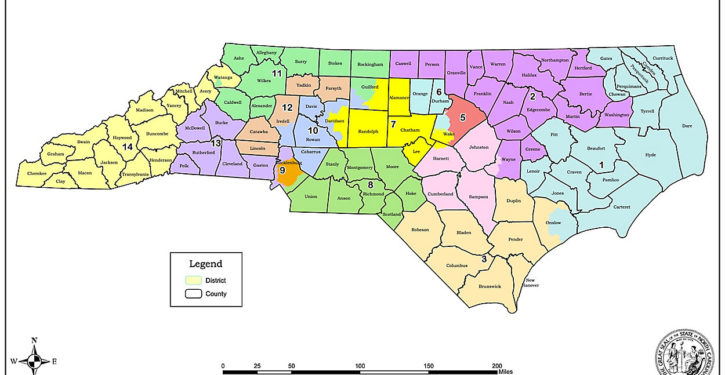
In a 4-to-3 ruling, the North Carolina Supreme Court has struck down the Congressional redistricting adopted by the state’s Republican-controlled legislature, calling it a partisan gerrymander, even though the state’s Congressional districts are not strangely-shaped, the way Democrat-drawn maps in Illinois, California, Maryland, and New York are.
But rather than impose a neutral Congressional map, the Court is likely to impose a Democratic gerrymander. The Court, which is composed mostly of Democratic justices elected in partisan elections, has ordered the state legislature to “submit new congressional and state legislative districting plans” by February 18. If those plans don’t satisfy progressive criteria, such as “efficiency gap analysis,” the court will likely draw up its own map.
The state supreme court says that “efficiency gap analysis” is a “reliable” way of “demonstrating the existence of an unconstitutional partisan gerrymander.” “Efficiency gap analysis” can effectively entitle a political party to proportional representation, even if it would naturally win fewer districts than the rival political party, because most of its supporters are so geographically concentrated in a small fraction of Congressional districts. In practice, it is usually affirmative action for Democrats, whose supporters are concentrated heavily in cities and inner suburbs.
When the Democrat-dominated Pennsylvania Supreme Court overturned the Congressional map enacted by the state’s Republican legislature, it adopted a map that favored Democrats, rather than one that was unbiased. As the New York Times noted, the “new map was better for the Democrats than all 500” alternative “congressional maps” that a political scientist at the University of Michigan had come up with in his “simulations.” The court itself had found a Republican gerrymander based on the fact that the Congressional map it struck down was worse for Democrats than all 500 of these alternative Congressional maps, saying that was “perhaps the most compelling evidence” of gerrymandering. So under the court’s own logic, it was guilty of gerrymandering, for producing a result more slanted in favor of a political party than any random simulation.
The map the Pennsylvania Supreme Court adopted was drawn to aid Democrats, to offset the fact that Democratic votes were mostly concentrated in urban areas, leaving most districts naturally Republican-leaning. The net result of its new map practicing affirmative action for Democrats was that Democrats got half the state’s Congressional seats in the 2020 election, despite receiving fewer votes than Republicans.
This result was particularly striking, because Republicans have a natural “geographical advantage because their voters” are “spread more widely across suburban and rural America instead of being highly concentrated, as Democrats generally are, in big cities,” according to the Associated Press. For example, there were 59 voting divisions in Philadelphia where Republican presidential candidate Mitt Romney got zero votes; no rural area in Pennsylvania was as uniformly hostile to President Obama as these urban areas were to Romney. It is this geographic concentration of Democrats in cities that makes it hard for them to take control of most state legislatures and state congressional delegations, unless there is a political gerrymander in their favor. The liberal Philadelphia Inquirer has conceded that naturally, there would be 110 Republican seats and only 93 Democratic seats in Pennsylvania’s state House. But the map adopted by the state’s Legislative Reapportionment Commission, which includes a tie-breaking member appointed by the progressive Pennsylvania Supreme Court, is expected to give Democrats a higher number of seats (99).
Given Republicans’ natural geographic advantage, totally random redistricting will tend to benefit Republicans. Progressive academics seek to eliminate this natural geographic edge for Republicans through the so-called “efficiency gap” standard. That standard could render unconstitutional many redistricting plans that ignore political voting patterns and other political considerations, and instead follow traditional, non-partisan districting principles, such as keeping districts as compact as possible. For example, even Iowa, which takes an unusually non-partisan approach to redistricting, usually has a substantial “efficiency gap,” and could run afoul of the progressive “efficiency-gap” standard.
The U.S. Supreme Court should strike down any Congressional map imposed by the North Carolina Supreme Court that favors Democrats. Legislatures are political bodies, and you can’t take the politics out of politics. So challenges to legislative political gerrymanders may not be justiciable, in most cases.
But gerrymanders by courts are a very different matter. They are intolerable. Judges must abide by “strict neutrality,” unlike politicians. (See Williams-Yulee v. Florida Bar, 135 S.Ct. 1656, 1666 (2014)).
Political discrimination or favoritism by a court is intolerable, and at odds with the First Amendment and the equal-protection component of the Fifth Amendment. (See Edmonson v. Leesville Concrete Co., 500 U.S. 614, 628 (1991) (“The injury caused by the discrimination is made more severe because the government permits it to occur within the courthouse itself.”)).
Political discrimination and gerrymanders by courts are forbidden, even if not those by state legislatures. State governments get more leeway than courts do to behave in a political manner, even when it affects the political process, or would otherwise raise First Amendment concerns. (See, e.g., U.S. Constitution, Article II, §1 (legislatures can pick presidential electors or dictate how they are picked); art. I, §4 (legislatures vested with Congressional redistricting); Easley v. Cromartie, 532 U.S. 234, 237 (2001) (race permitted as non-predominant factor in legislative redistricting, despite general constitutional ban on using race)).
Courts, by contrast, are fully subject to the First Amendment and constitutional equal-protection requirements. (See Near v. Minnesota, 283 U.S. 697 (1931) (state court injunction against libel violated First Amendment); Snyder v. Phelps, 562 U.S. 443 (2011) (damage awards imposed by courts are subject to First Amendment limits); Rose v. Mitchell, 443 U.S. 545, 556 (1979) (forbidding racially conscious judicial proceedings)).



